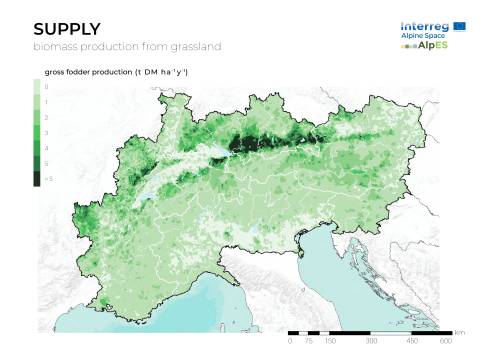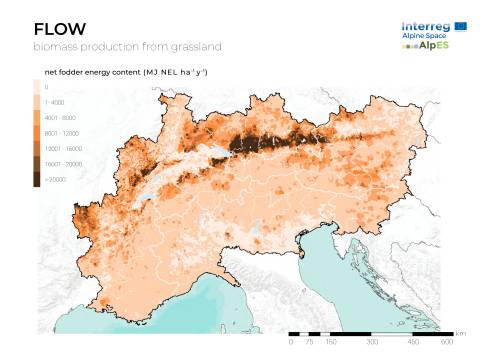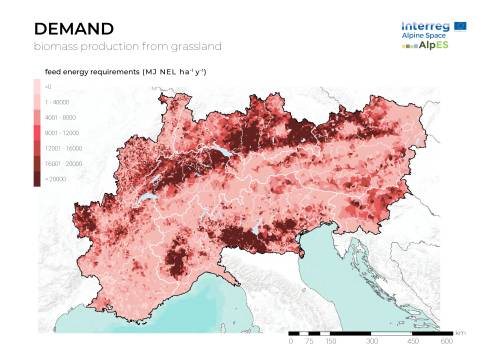Biomass production from grassland in the Alps
The Alpine Space has a long history of grassland production, a history that has shaped the many cultures across this range. In most corners of the Alps, one can still find traditional farms raising livestock such as cows, goats, horses and sheep on alpine pastures. These pastures are fairly common because the high altitudes and steep slopes of much of the Alps make most other means of agricultural production unfeasible in these areas. The milk, meat, and local varieties of cheese that these operations produce are important for maintaining the cultural integrity of traditional rural ways of life and they all depend on a major ecosystem service: grassland biomass growth. Every year, alpine communities benefit from the fodder that grows freely in high elevation meadows as cows and other livestock transform this grassy material into valuable food products.
Assessing this service is done in three ways: by measuring the total amount of grassland biomass that is produced, by measuring the amount of grassland biomass that is actually consumed by livestock, and by measuring the total energetic needs of livestock farmers, to compare with what is provided. Understanding the supply, flow, and demand, on this ecosystem service will help to inform decisions made by natural resource managers, spatial planners, farmers, politicians, and scientists in the Alps. Ultimately, such informed decisions will be vital in protecting traditional ways of life and cultures across the Alpine Space.
Supply

View this map in the AlpES webGIS
Grassland farming is a dominant factor in the agricultural landscape of the Alps. But not all meadows are the same: biomass supply depends firstly on the growth rate of all grassland types that are used as fodder. These can vary between extensive meadows, frequently cut pastures, and natural grassland found at high altitudes. Moreover, grasslands also differ in their plant composition, and in the use of fertilizers and management (cutting) levels. Finally, climatic parameters like the number of vegetation days, precipitation and energy budget of the grassland plot strongly influence the productivity of different grasslands. The map shows a hotspot of grassland biomass supply in lower Germany, namely the regions of Schwaben and Oberbayern, where the lower altitudes and abundant precipitation favour the growth of grassland. This area is indeed rich in pastures, as is observable in the CLC12 layer in the AlpES WebGIS. Other lowland areas, like the Po valley in Italy, the north of Switzerland and eastern Austria, have low values of this indicator, as the land is used for croplands, orchards, vineyards, arable lands and other cultivation types, and little space is dedicated to permanentgrassland farming. High grassland biomass supply levels are important especially in areas where the agricultural and farming tradition is thriving.
Recent socio-economic trends saw a drop in the number of Alpine farmers, with about 20% of the agricultural land of the Alps being abandoned (Muheim & Meier, 2017). These plots of land previously managed for grassland farming are lost to scrub encroachment and reforestation, to the detriment of biodiversity and landscape diversity. Indeed, traditionally managed grasslands rank among the habitats with the highest species richness in Alpine regions, in terms of both plant diversity and animal species that use this habitat during their life cycle (Muheim & Meier, 2017). Alpine grasslands are also subject to many threats. Livestock grazing, and in particular trampling and fertilization from accumulated excrement, can cause significant changes in the vegetation.
Another major threat to Alpine grasslands is winter recreation and the related tourism flow. The establishment of ski resorts often affects the phenology of the underlying vegetation and promotes soil erosion, which may ultimately result in changed plant composition and a higher proportion of unvegetated ground.
Flow

View this map in the AlpES webGIS
The consumed amount of grassland biomass depends on three factors: (1) the supply of grassland from the ecosystem, (2) the usage intensity, i.e. the cutting frequency of the pastures and (3) the loss of material during the harvesting and storage processes. The flow indicator is calculated as an energy measure, which takes into account the forage quality of the consumed biomass and its relative total energy content. Differences in the terrain, nutrient availability and use of fertilizers, also affect both the productivity of extensive grasslands and the quality of the end product. The pattern of this map resembles the previous supply indicator map in that the highest flow rates are observed in Germany, whereas the lowest values appear again in the Italian and Swiss plains. Since this indicator is a measure of the used fraction of the local yield, the highsimilarity of the two maps should not come as a surprise.
Demand

View this map in the AlpES webGIS
As most cultivation types are difficult to maintain in the rough Alpine environment, with its steep terrain and harsh climate, farmers have instead focused on the production of animal-derived products like milk, cheese and meat. Dairy and beef cows have therefore become common in the Alpine landscape, along with equine species, sheep and goats. The demand for grassland-derived forage varies greatly with the composition of the herd and the age and gender of the animals. The energetic costs required by animals for milk production were also included in the calculations, based on the average amount of milk produced per municipality. Nowadays, such energetic requirements are largely satisfied with the consumption of additional fodder and nutritional supplements, as local grassland farming alone is often insufficient. The resulting map shows that the largest demand is located in the northern foothills of the Alps and in the Po valley, where great numbers of cattle are present. In these areas, the high demand for fodder is satisfied through multiple sources: concentrated feed, biomass from local grasslands and imported biomass, transported from other production zones. The steepness and ruggedness of the central mountains preclude the management of large herds of animals.